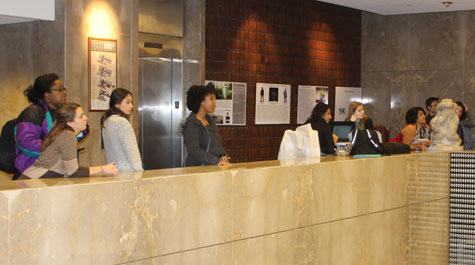Lining the walls of Earl Gregg Swem Library’s Botetourt Gallery is a collection of photo illustrations and news clippings from prominent African-American newspapers such as The Richmond Planet detailing the lives of the Buffalo Soldiers involved in the Philippine-American War.
The exhibit is courtesy of efforts by the Asian and Pacific Islander American Studies Program of the College of William and Mary and other organizations.
To bring this collection to the College, APIA studies worked with Norfolk State University and organizations including the Filipino American National Historical Society — Hampton Roads chapter — and the Virginia Foundation for the Humanities. The exhibit, titled “Hidden Virginia History: The Connection between the Buffalo Soldiers and the Philippines,” will be displayed until May 15.
The exhibit focuses on African-American service members, or “Buffalo Soldiers,” who served during the conflict, such as Sgt. Sanford M. Thomas and Walter Howard Loving, the latter of whom calls the Philippines home.
Theatre and Asian and Pacific Islander American studies professor Francis Tanglao-Aguas discussed the motivation for and subject matter of the new exhibit.
[The exhibit] shows the intersections, convergences and collaborations of the experience of people of color under a system founded on racism,” Tanglao-Aguas said.
“[The exhibit] shows the intersections, convergences and collaborations of the experience of people of color under a system founded on racism,” Tanglao-Aguas said.
Other African-American individuals who documented the service members’ involvement, including the Planet’s publisher John Mitchell, Jr., were featured in the photo illustrations. Vice president of the FANHS-HR chapter and adjunct professor of U.S. history at Tidewater Community College Jeffrey Acosta, the lead historian of the exhibit, credited the work of John Mitchell, Jr. for sharing the experiences of African-American service members.
“But if it had not been for John Mitchell, Jr., the publisher of the Planet who published letters written to his newspaper by black soldiers serving in the U.S. Army during the Spanish-American and Philippine-American Wars, we may have never known what truly went on,” Acosta said in a press release.
David Fagen, one of nine African-American soldiers who defected to the Army of the First Philippine Republic, is featured in the exhibit.
According to information provided by a photo illustration of Fagen, the soldier faced disciplinary action and was frustrated with the United States’ racism toward both African-Americans and Filipinos.
Tanglao-Aguas noted that Fagen was a controversial but important figure.
“You need an individual to stop collective behavior, because otherwise you won’t feel free if you’re just moving with the rest of the cattle,” Tanglao-Aguas said. “I’m not saying what [Fagen] did was right, but what he did allows people to ask questions. Before moving with the critical mass, you go into reflection. What does it mean to be free?”
Pallavi Rudraraju ’17, an APIA studies major, visited the exhibit with fellow students from Tanglao-Aguas’s course, Sex and Race in Film and Plays, along with the class of APIA studies professor R. Benedito Ferrão, who is one of the newest professors given tenure-track as an assistant professor in the program. Rudraraju said she believes that viewing the exhibit alongside her peers was critical to the overall experience.
“Being able to be there with these other people who are studying this sort of topic, it’s just really important,” Rudraraju said. “It’s really difficult to find scholarship on Asian and Asian-Americans and anything which highlights even military presence. It was just bringing to light a lot of things which were really integral and important for these students to know.”
To Rudraraju, the exhibit’s focus on the Buffalo Soldiers and their involvement with the Filipino revolutionaries of the Philippine-American War successfully demonstrated the intertwinement of history between African and Asian-American groups.
“It’s highlighting … how these two groups are not as separate as people might think,” Rudraraju said. “Throughout history especially, black Americans have been so important in terms of Asian and Asian-American history, and that’s why I am absolutely thrilled about this exhibit.”
City Council member Benny Zhang ’16 noted that the exhibit was a testament to how important the role of APIA studies is in fostering awareness.
Zhang, who graduated from APIA studies and examined the significance of the College’s first Asian-American student, Art Matsu in his senior thesis, noted that there “is a comfort with the space created to challenge historical norms right now.”
[The exhibit] is a testament also to William and Mary’s environment where it enables folks, students, faculty members, staff, and researchers to kind of really challenge the notion of how we understand history today,” Zhang said.
“[The exhibit] is a testament also to William and Mary’s environment where it enables folks, students, faculty members, staff, and researchers to kind of really challenge the notion of how we understand history today,” Zhang said. “I think understanding history in one way is quite dangerous but having a more holistic way of understanding of history I think only enables us to advance certain ideas forward.”
Rudraraju said that the exhibit also conveys the importance of being a good ally to black Americans as a good APIA activist, and is an important step toward the expansion of inclusivity within the program.
Tanglao-Aguas said he agrees with the potential that APIA studies and other programs have amassed.
“I think programs like APIA and Africana studies can possibly give us opportunities to make some changes for the better in society,” Tanglao-Aguas said. “And I do mean everybody. Not only people who look like the cultures in the titles of these programs. Because we are all in the same space.”

































